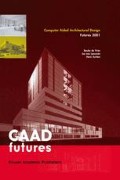Abstract
In the early stages of the building design process, during the programming and the proposal stages, both user activities and the building are in focus for the designer. In spite of this, today’s CAD programs give no support for management of information about user activities in the building. This paper discusses the requirements on modelling user activities in the context of building design and presents a prototype software. The prototype is developed as an add-on to the architectural design software ArchiCAD.
Access this chapter
Tax calculation will be finalised at checkout
Purchases are for personal use only
Preview
Unable to display preview. Download preview PDF.
References
Akademiska Hus, 2000, “RFP-template”, Akademiska Hus, Lund.
Alexander C., 1975, A Timeless Way of Building, Oxford University Press, New York.
Bubenko jr J. A., 1993, “Extending the scope of information modelling”, Report Nr. DSV 93-034. Department of Computer and Systems Science, KTH, Stockholm.
Bunge M., 1977, Ontology I: The Furniture of the World, Vol. 3 of Treatise on Basic Philosophy, Reidel, Dordrecht and Boston.
Bunge M., 1979, Ontology II: A World of Systems, Vol. 4 of Treatise on Basic Philosophy Reidel, Dordrecht and Boston.
Bunge M., 1983, Epistemology and Methodology I: Exploring the World, Vol. 5 of Treatise on Basic Philosophy, Reidel, Dordrecht and Boston.
Carrara G., Y. E. Kalay and G. Novembri, 1994, “Knowledge based computational support for architectural design”, Automation in Construction, 3(2–3), p. 157–175.
Checkland P., 1981, Systems Thinking, Systems Practice, John Wiley & Sons, Chichester.
Child J., 1984, Organization: A guide to problems and practice, Paul Chapman Publ. London.
Eastman C. (1999) Building Product Models: Computer Environments Supporting Design and Construction, CRC Pr, London.
Eastman C. M. and A. Siabiris, 1995, “A generic building product model incorporating building type information”, Automation in Construction, 3(4), p. 283–304.
Flemming U. and S.-F. Chien, 1995, “Schematic lay-out design in SEED environment” Journal of Architectural Engineering, 1(4), p. 162–169.
Ekholm A., 1994, “A systemic approach to building modelling — analysis of some object-oriented building product models”, in: Björk, B.-C. (ed.) CIB W78 Workshop, Aug. 22–24 1994, Esbo, Finland.
Ekholm A., 1987, Systemet Människa-Byggnadsverk. Ett ontologiskt perspektiv, Statens råd för byggnadsforskning R22:1987, Stockholm.
Ekholm A. and S. Fridqvist, 2000, “A concept of space for building classification, product modelling, and design”, Automation in Construction, 9(3), p. 315–328.
Ekholm A. and S. Fridqvist, 1998, “A dynamic information system for design applied to the construction context”, in: Björk B.-C. and A. Jägbeck (eds) The Life-Cycle of IT Innovations: Proceedings of the CIB W78 Conference, June 3–5, 1998. Royal Institute of Technology, Stockholm.
Ekholm A. and S. Fridqvist, 1996, “Modelling of user organisations, buildings and spaces for the design process”, in Turk Z. (ed.) Construction on the Information Highway. Proceedings from the CIB W78 Workshop, 10–12 June 1996, Bled, Slovenia. CIB, ?
Habraken J., J. Boekholt, A. Thyssen and P. Dinjens, 1974, Variations, The Systematic Design of Supports, MIT Press, Cambridge.
Hales H. L., 1984, Computer-aided facilities planning. Vol. 9 of Industrial engineering, Marcel Dekker Inc., New York.
Hendricx A., 2000, A core object model for architectural design. Departement Architectuur, Katholieke Universiteit Leuven, Leuven.
Kalay Y. and C.H. Séquin, 1998, “A Suite of Prototype CAD Tools to Support Early Phases of Architectural Design”, Automation in Construction, 7(6):449–464.
Kumlin R. R., 1995, Architectural Programming. McGraw-Hill, Inc., New York.
Muther R., 1973, Systematic Layout Planning, Cahners Books, Boston.
Schenck D. A., and P. R. Wilson, 1994, Information modelling: The EXPRESS Way, Oxford University Press, Oxford.
Svensson K., H. Yngve, and C. Bergenudd, 1999, Förvaltningshandlingar 2000. Slutrapport. Byggstandardiseringen, Stockholm.
Author information
Authors and Affiliations
Editor information
Editors and Affiliations
Rights and permissions
Copyright information
© 2001 Springer Science+Business Media Dordrecht
About this paper
Cite this paper
Ekholm, A. (2001). Activity Objects in CAD-programs for building design. In: de Vries, B., van Leeuwen, J., Achten, H. (eds) Computer Aided Architectural Design Futures 2001. Springer, Dordrecht. https://doi.org/10.1007/978-94-010-0868-6_5
Download citation
DOI: https://doi.org/10.1007/978-94-010-0868-6_5
Publisher Name: Springer, Dordrecht
Print ISBN: 978-94-010-3843-0
Online ISBN: 978-94-010-0868-6
eBook Packages: Springer Book Archive

